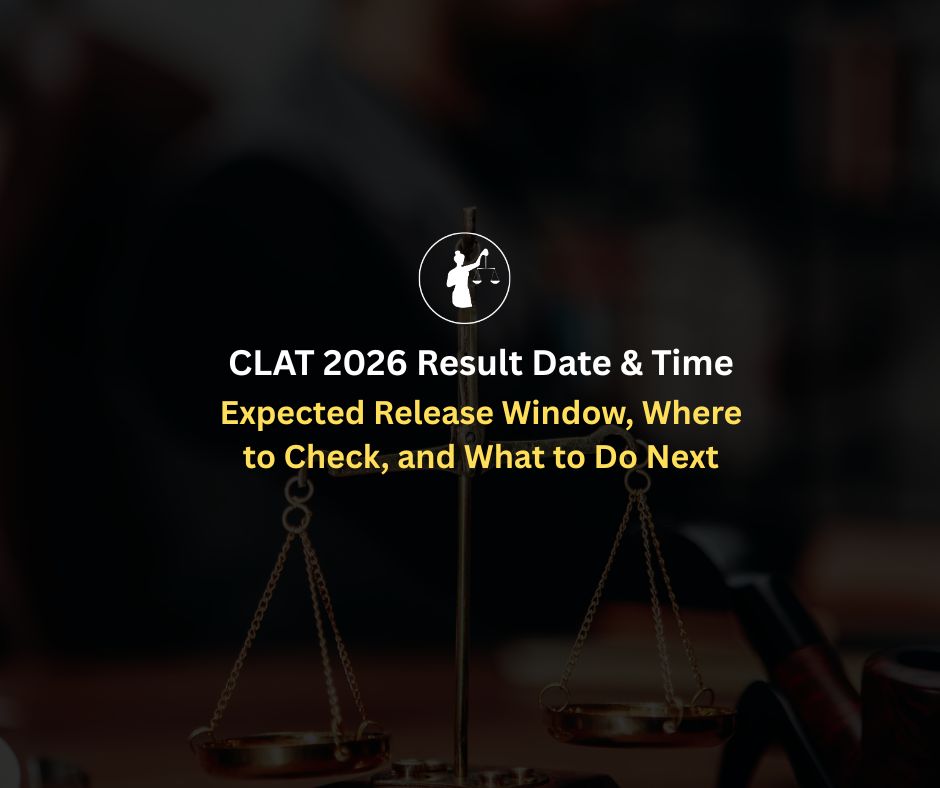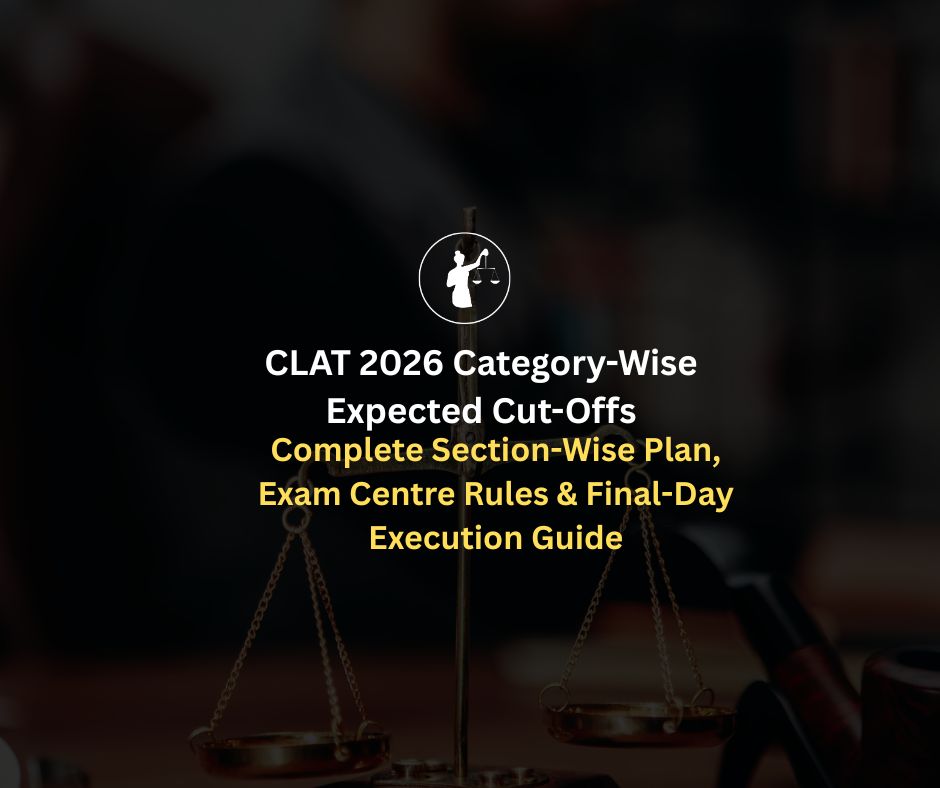The CLAT 2026 (Common Law Admission Test) is the gateway to India’s top National Law Universities (NLUs) for undergraduate (UG) and postgraduate (PG) law programs.
Signup to NLTI for free Mockups, past papers and much more
It is a highly competitive national-level entrance exam conducted annually by the Consortium of NLUs. The exam tests candidates on their reading, reasoning, and analytical abilities through a comprehension-based format.
The CLAT Exam pattern consists of five sections:
English Language –
Comprehension-based passages
Current Affairs & General Knowledge –
Focus on recent events
Legal Reasoning –
Legal principles & application
Logical Reasoning –
Analytical & logical puzzles
Quantitative Techniques –
Mathematical problem-solving
Candidates need to answer 120 multiple-choice questions within 2 hours, with negative marking of 0.25 marks per incorrect response. Understanding the CLAT Question type and marking scheme is crucial to securing a high rank.
Dig Deeper: CLAT 2026 Preparation Strategy
A well-structured preparation plan starts with a clear understanding of the CLAT Exam pattern. Here’s why it is essential:
Strategic Preparation:
Knowing the question types helps candidates focus on high-weightage topics.
Time Management:
Understanding the section-wise format aids in allocating time effectively.
Avoiding Surprises:
Familiarity with the exam structure reduces stress and boosts confidence.
Optimized Practice:
Practicing mock tests based on the actual pattern improves accuracy and speed.
By mastering the CLAT 2026 exam pattern, aspirants can develop an efficient study plan and improve their chances of admission to a top NLU.
Understanding the CLAT 2026 Exam Pattern is essential for effective preparation. The exam follows a comprehension-based approach, assessing candidates on reading, reasoning, and analytical skills. Here’s a breakdown of the key details:
The CLAT Exam 2026 will consist of 120 multiple-choice questions (MCQs), with each question carrying 1 mark. The total marks for the exam will be 120, and there will be a negative marking of 0.25 marks for every incorrect answer.
The CLAT 2026 Exam will be conducted in offline mode (pen-and-paper-based test). Candidates will be given an OMR (Optical Mark Recognition) sheet to mark their answers.
The total duration of the CLAT 2026 Exam will be 2 hours (120 minutes). Candidates must manage their time effectively across different sections to maximize their score.
Dig Deeper: Best Books for CLAT Preparation
The CLAT Exam pattern is divided into five key sections, each assessing different skills. The distribution of questions among these sections is as follows:
Each section consists of comprehension-based CLAT Question types, requiring candidates to read passages and answer questions based on logical and analytical reasoning.
Comprehension-based questions dominate the paper, making reading speed and accuracy essential.
Time management is crucial since all 120 questions must be completed in 120 minutes.
Understanding the weightage of each section helps in prioritizing preparation.
By mastering the CLAT 2026 Exam pattern, candidates can enhance their preparation strategy and increase their chances of success.
The CLAT 2026 Exam consists of five sections, each designed to test different skills such as reading comprehension, reasoning, legal aptitude, and mathematical ability.
A solid understanding of the CLAT Exam pattern and CLAT Question types in each section is crucial for effective preparation.
The English Language Section in CLAT 2026 will assess candidates’ proficiency in reading comprehension, grammar, and vocabulary.
Types of Questions:
Comprehension-based questions based on passages (~450 words)
Inference & contextual meaning of words
Grammar-based questions (sentence correction, fill in the blanks)
Synonyms & antonyms
Tone & intent of the passage
Difficulty Level: Moderate to High (Strong reading skills are essential)
The Current Affairs & GK section in CLAT 2026 will focus on recent events and general knowledge.
Focus Areas:
National & International Events (Last 6–12 months)
Legal Developments (Important court judgments, amendments)
Government Policies & Schemes
Sports, Awards & Books
Historical & Static GK Topics
Key Topics to Focus On:
The Legal Reasoning section in CLAT 2026 is one of the most critical parts of the exam, as it tests a candidate’s ability to apply legal principles to factual scenarios.
Importance:
No prior legal knowledge is required, but general awareness helps
Tests logical application rather than rote memorization
Common Question Formats:
Principle-Fact Based Questions (Applying legal principles to cases)
Legal Maxims & Concepts (Basic legal terms, constitutional rights)
Judicial Precedents & Case Laws (Understanding judgments)
Legal Current Affairs (New laws, amendments, landmark cases)
Difficulty Level: Moderate to High (Critical thinking skills are required)
The Logical Reasoning section in CLAT 2026 tests analytical skills, pattern recognition, and logical deduction.
Types of Logical Puzzles & Questions:
Critical Reasoning Questions (Assumptions, Inferences, Strengthen/Weaken arguments)
Logical Deductions & Syllogisms
Statement & Conclusion Questions
Blood Relations, Coding-Decoding, Directions
Cause & Effect Analysis
Difficulty Level: Moderate (Regular practice improves accuracy)
The Quantitative Techniques section in CLAT 2026 assesses basic mathematical skills and numerical reasoning.
Weightage & Level of Difficulty:
10-14 questions, mostly data interpretation & arithmetic-based
Questions will be passage-based numerical problems
No advanced mathematics (only Class 10 level math)
Key Topics:
Understanding the CLAT Exam pattern and marking scheme is essential for effective preparation and strategic answering. The CLAT 2026 follows a structured marking system that impacts the overall score, including marks per question, negative marking policy, and score calculation.
The CLAT 2026 Exam consists of 150 multiple-choice questions (MCQs), each carrying 1 mark. Candidates will be awarded marks based on the number of correct answers they provide.
Marking Structure:
Total Questions: 150
Marks Per Question: +1 for every correct answer
Total Marks: 150
Dig Deeper: CLAT Syllabus 2026: Subject-Wise Breakdown & Important Tips
The CLAT 2026 Exam follows a negative marking system to discourage random guessing.
Penalty for Incorrect Answers:
Negative Marking: -0.25 (¼ mark) for each incorrect answer
Unanswered Questions: No marks deducted
Accuracy Matters:
Since negative marking is applicable, avoid blind guessing. Attempt only those questions where you are reasonably confident.
Strategic Question Selection:
If unsure about an answer, it is better to skip than lose 0.25 marks per wrong attempt.
Time Management & Mock Tests:
Regular practice with CLAT mock tests helps candidates analyze their scoring trends and improve accuracy.
By understanding the CLAT Exam pattern, marking scheme, and question types, candidates can maximize their scores while minimizing negative marking
Cracking CLAT 2026 requires a smart preparation strategy aligned with the CLAT exam pattern and CLAT question types. S
ince the CLAT exam is highly competitive, candidates must focus on time management, an effective study plan, and regular mock test practice.
Below are some expert-backed strategies to help aspirants maximize their scores.
The CLAT 2026 Exam is 2 hours (120 minutes) long and consists of 150 multiple-choice questions. With limited time, managing time effectively is crucial for maximizing attempts while maintaining accuracy.
Prioritize Strengths –
Start with sections you are comfortable with to gain momentum.
Set a Time Limit Per Question –
Ideally, spend less than 45 seconds per question to avoid wasting time.
Use Skipping Strategy –
If stuck, move on and return later to avoid losing time on difficult questions.
Practice with Timed Mock Tests –
Simulating exam conditions enhances speed and accuracy.
A well-structured CLAT 2026 preparation plan ensures comprehensive coverage of all subjects. Here’s how to approach each section:
Focus Areas: Reading comprehension, vocabulary, grammar, and inference-based questions.
Strategy:
Read newspapers like The Hindu or Indian Express to improve comprehension.
Practice editorial-based RCs for better understanding of complex passages.
Revise grammar rules and practice para jumbles and sentence correction questions.
Focus Areas: Static GK, legal GK, important national and international events.
Strategy:
Read daily news updates from The Hindu, Live Law, and PIB.
Prepare monthly GK notes covering legal judgments, government schemes, and international affairs.
Attempt daily quizzes to retain information better.
Focus Areas: Legal principles, case laws, and application-based questions.
Strategy:
Understand legal concepts like contracts, torts, and constitutional law.
Solve past CLAT papers to recognize question patterns.
Focus on principle-based reasoning and analytical skills.
Focus Areas: Statement-based reasoning, puzzles, critical reasoning.
Strategy:
Practice syllogisms, blood relations, and assumption-based questions.
Strengthen deductive and inductive reasoning by solving puzzles and previous year questions.
Attempt at least 10 reasoning questions daily to build accuracy.
Focus Areas: Arithmetic, data interpretation, percentage, profit & loss, and time-speed-distance.
Strategy:
Revise basic concepts from NCERT Class 9 & 10 Maths.
Focus on data interpretation (DI) and percentage-based problems.
Solve at least 10-15 quantitative aptitude questions daily.
Helps to understand the level of difficulty and types of questions.
Enhances the ability to solve questions under timed conditions.
Helps refine strategies for specific sections.
Identify Repeated Question Patterns – CLAT often follows consistent trends in question framing.
Evaluate Time Consumption Per Section – Focus on areas where you spend excessive time.
Work on Weak Areas – After each test, analyze mistakes and re-attempt incorrect questions.
Cracking CLAT 2026 requires a thorough understanding of the CLAT exam pattern, question types, and marking scheme.
By focusing on time management, section-wise preparation, and mock test analysis, aspirants can significantly improve their performance. Regular practice, staying updated with current affairs, and refining legal reasoning skills are key to securing a top rank in the CLAT exam.
Check Out CLAT Courses at NLTI, we provide comprehensive Online CLAT coaching, expert mentorship, high-quality mock tests, and in-depth past paper analysis to help you ace the exam with confidence.





